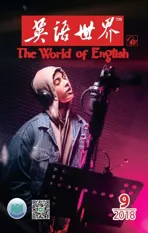Hip-hop as Therapy:The Healing Qualities of Rap
2018-11-28唐娜克莱尔切斯曼周厚娟
文/唐娜-克莱尔·切斯曼 译/周厚娟
So many of our favorite artists have expressed that making music is their form of therapy. And as fans, we often listen to music as a means of coping with our own struggles.
[2] Think of Isaiah Rashad1来自田纳西州的嘻哈歌手和专辑制作人。《太阳的长篇演说》为其首张录音室专辑,2016年一发行就在美国公告牌排行榜前200中排第17位,首周销量1.9万张。’s The Sun’s Tirade, an album that Rashad had to fight through addiction and depression to deliver to his fans. Throughout the project, he dealt leveling2level摧毁。blows,rapping about potentially hanging himself and the stagnancy of his depression.Writing those lyrics helped Rashad through the situation and gave listeners the comfort to know they were not alone.
太多深受我们喜爱的音乐人都曾表示做音乐于他们而言是一种心理治疗。作为粉丝,我们也时常将听音乐当作一种应对困难的方式。
[2]以赛亚·拉沙德经历了跟毒瘾和抑郁症的抗争,制作出《太阳的长篇演说》这张专辑,呈现给粉丝。制作专辑的过程中,他战胜了种种挫折,歌词描述他曾想上吊自杀以及陷入的抑郁困境。写那些歌词让拉沙德挺了过来,也使歌迷们得到慰藉:他们得知原来自己并非个例。
[3] Rob Jackson, co-founder of the hip-hop focused therapy program Beats Rhymes and Life, points out that hiphop has a long history of healing: “The principles of hip-hop are rooted in giving voice to the oppressed and resisting oppressive systems, political advocacy,vibrant youth expression, and raising public conscious and awareness.The ability to tell one’s story from a strength-based perspective3指优势心理学(strengths-based psychology)的角度。盖洛普公司前董事长、优势测评工具StrengthsFinder的主设计人、“优势心理学之父”唐纳德·O.克利夫顿(Donald O.Clifton)认为,每个人独有的优势和能力(而非短板)将决定他们的成长故事、塑造他们的自我。, which allows youth to reframe the narrative that has been told to them or they often believe themselves, is critical to both healing and development.”
[4] Sometimes, that healing can have a physical impact on an artist. During an interview in 2016, Isaiah Rashad described music expression as working out: “After you’re done with it, you feel better? It’s like that. It’s like that with music and shit… I thought by therapy you meant some spill-the-beans-youfeel-better4spill the beans〈非正式〉无意或不慎揭露秘密信息。shit. Nah, it’s like a mental therapy, physical thing.”
[5] Jackson agrees that there is a major difference between traditional talk therapy and therapy through hip-hop:trust. Hip-hop therapy is able to access a patient’s trust in a more conscious way than traditional therapy.
[6] Music therapist and veteran educator Michele Schnur Ritholz explains that music is an innate part of the human experience, and at our core we feel a connection to various musical elements.
[3]嘻哈治疗项目“节奏、韵律与生活”的联合创始人罗布·杰克逊指出嘻哈乐有着悠久的治愈史:“嘻哈的信念根植于让被压迫者发声和反抗压迫体制、表达政治主张、青年充满活力的表达以及唤起公众意识。从优势心理学的角度讲述一个让青年人可以改写他们一直以来听说或经常信以为真的故事,这种能力对于疗愈和发展都至关重要。”
[4]有时,这种治疗会对音乐人产生实质影响。在2016年接受的一个采访中,以赛亚·拉沙德把音乐表达比喻成锻炼:“锻炼完,你感觉更好吧?就是那种感觉。音乐和大便给你同样的快感……我以前以为所谓心理治疗,就是‘秘密一吐为快’的那种废话。其实不是,音乐是一种有实质影响的精神治疗。”
[5]杰克逊认同传统的谈话疗法和嘻哈疗法之间存在巨大的不同点:信任。与传统疗法相比,嘻哈疗法在意识上更容易让患者产生信任感。
[6]音乐治疗师、资深教育家米歇尔·施努尔·里托兹解释说,音乐是人类与生俱来的一种体验,在内心深处我们感受得到跟各种音乐元素的联系。
[7] Speaking directly to hip-hop,Jackson adds: “The foundation of hiphop is grounded in African drums, jazz,blues, R&B, reggae, funk, and soul, and therefore it embodies the pain, struggle,innovation, and triumphs that the listener is having a visceral5visceral(未经过认真思考而)出自内心的,发自肺腑的。reaction to.”
[8] That reaction allows listeners to build a deeper connection to their music, which in turn gives them a sense of community similar to the group atmosphere that Jackson underscores within his own therapy program. Ritholz agrees, suggesting that the relationship we build with our music is unique and easy to become enrapt6enrapt狂喜的。in. Fans often crediting their favorite albums or artists for giving them the strength to push through their darkest times.
[9] Asked if there are specific ways fans can engage with music to turn a casual listening session into a healing experience, Ritholz suggested lyrical analysis, which is second nature7second nature第二天性;习性。to hiphop fans.
[7]论及嘻哈,杰克逊补充说道:“嘻哈根植于非洲鼓乐、爵士、布鲁斯、节奏布鲁斯、雷鬼、放克和灵乐,因此它也包含了听众从内心深处产生共鸣的痛苦、挣扎、创新和成功。”
[8]此种情感共鸣使得听众能够在自身和音乐之间建立更深刻的联系,进而赋予他们一种社群意识,类似于杰克逊在他自己的治疗项目中强调的集体氛围。里托兹同意这一观点,并暗示我们跟音乐之间建立的关系独一无二,让人容易心醉神迷。粉丝们经常将给予他们力量挺过低迷时期的专辑或歌手视为最爱。
[9]当被问及有没有什么特别的方法能让粉丝将普通的听歌过程转化为治疗体验,里托兹的建议是分析歌词,这是嘻哈乐迷的第二天性。
[10] “Next time your favorite song is on, listen with intention!” Jackson says,explaining how listeners can simulate the effects of structured music therapy from home. “Make it part of your selfcare practice so it’s not just ‘I listen to music while I’m doing a mundane task,’ but ‘I listen to the music, on the couch, with a candle lit and meditate with it.’ Allow music to de fine moments of peace and happiness, so that every time you hear a particular song you are reminded of how good you feel or felt.”
[11] Understanding that rap music has the ability to be an especially effective form of music therapy, Jackson has developed a unique 16-week hip-hop therapy program of his own.
[12] “Beats Rhymes and Life is the first in the world to use the combination of a teaching artist, clinical socialworker, and peer mentor, to deliver therapeutic services,” he explains. “The youth participate in a two hour process day and a two hour lab day each week.”
[13] “The process day is designed to engage youth in a curriculum that inspires critical analysis and discussions that we turn into bars8bar〈音乐〉小节,指音乐被切分为时长相等的片段,在五线谱上通过垂直线来表示。and lyrics,” Jackson continues. “The youth then record their bars during the lab day, which are then turned into songs that go on a final group album. At the end of the sixteen weeks, the youth perform their music for an audience comprised of people who are invested in the youth’s lives.”
[14] Ritholz explains the power of music making as a healing tool for depression: “With or without words,clients may be activated to play when usually passive, express feelings, and move toward other emotional states as they feel enlivened and comforted by the music.”
[10]“下次听到你最爱的歌,仔细听!”杰克逊说道,并解释听众如何在家里体验到系统音乐疗法的效果。“让听音乐成为自我关怀练习的一部分,不仅仅是‘我边做琐事边听音乐’,而是‘我点上蜡烛,躺在沙发上边听音乐边沉思’。让音乐来定义那些平静和欢愉的时刻,这样每次你听到一首歌,你就会想起你正在经历的或是曾经经历过的美好。”
[11]杰克逊认识到说唱音乐能够成为一种尤其有效的音乐治疗形式,便推出了他自己研发的为期16周的独特嘻哈疗程。
[12]“‘节奏、韵律和生活’是世界首个集音乐教育家、门诊社工以及朋辈导师多重身份于一体、具有治疗功能的项目。”他解释道,“他们每周要参与一个两小时疗程日和一个两小时实验室日。”
[13]“疗程日的设定是为了让年轻人参与到能够启发批判性分析和讨论的课程中,而那些分析和讨论我们可以转变成小段旋律和歌词。”杰克逊继续说道,“在实验室日,这些年轻人可以录制自己的歌曲片段,然后制作成完整的歌曲,最终集合成为一张唱片。第16周,他们向观众——那些他们生命中重要的人,演奏自己的音乐。”
[14]论及音乐制作作为抑郁症的疗愈手段所具有的力量,里托兹解释道:“无论音乐有没有歌词,那些通常消极被动的患者可能被激发起来演奏,表达情感,当他们感到音乐的鼓舞和慰藉时,便会向其他情绪状态靠近。”
[15] Ritholz says that the process of writing music and creating a safe space for their thoughts allows patients to become more comfortable with themselves and their ideas. Jackson seconds9second附议;支持,赞成(提议)。her sentiments: “Youth are given the opportunity to externalize with words on paper the dif ficult emotions that they are processing internally. Writing bars allows the youth more opportunity to gain insight for themselves.”
[16] Group therapy allows clients to develop a sense of purpose and belonging. The group atmosphere could be likened to the support an artist may get from their fellow artists as well as their community of dedicated fans. Recall the opening voice mail on The Sun’s Tirade,where Dave Free reminds Rashad that he has a host of fans eager to hold him and his music up.
[17] Those same fans build a community for themselves when rooting for an artist. In turn, they create an outlet to discuss the music and their own struggles. Listening to your favorite album when you’re looking to get through a tough time becomes therapeutic in the same way as it was for the artist in the studio. ■
[15]里托兹表示,通过写音乐,为自己的思想打造一个避风港,患者更容易接受自己和自己的想法。杰克逊表示认同她的观点:“年轻人有机会通过写下文字来表达他们内心正在经历的复杂感受。写作音乐小曲给年轻人更多了解自己的机会。”
[16]小组治疗让患者能够产生一种目的感和归属感。小组氛围所给予患者的就好比一个音乐人从他的同行及其忠实粉丝群体那里得到的支持。试回想《太阳的长篇演说》中一开始的语音留言,在这条信息中,戴夫·弗里提醒拉沙德还有一大群粉丝支持他和他的音乐。
[17]同样是那些粉丝,在支持一个歌手的同时建立了一个社群。他们反过来创造了一个可以讨论音乐和自身困境的出口。苦于挣扎如何渡过艰难时期时,听最喜欢的专辑所具有的疗愈性跟歌手制作音乐别无二致。 □
